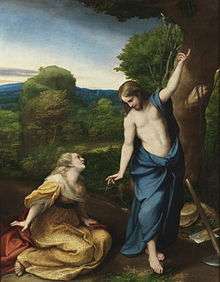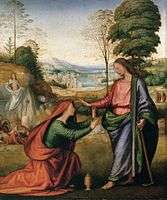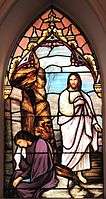Noli me tangere

Noli me tangere is the Latin version of a phrase spoken, according to John 20:17, by Jesus to Mary Magdalene when she recognized him after his resurrection.
A loose translation into English would be "don't tread on me"[1][2][3] or "don't touch me." The original Koine Greek phrase, Μή μου ἅπτου (mē mou haptou), is better represented in translation as "cease holding on to me" or "stop clinging to me".[4]
The biblical scene of Mary Magdalene's recognizing Jesus Christ after his resurrection became the subject of a long, widespread and continuous iconographic tradition in Christian art from Late Antiquity to the present.[5] Pablo Picasso, for example, used the painting Noli me tangere by Antonio da Correggio, stored in the Museo del Prado, as an iconographic source for his famous painting La Vie (Cleveland Museum of Art) from the so-called Blue Period.[6]
The words were also occasionally used to describe a disease known to medieval physicians as a "hidden cancer" or cancer absconditus, as the more the swellings associated with these cancers were handled, the worse they became.[7]
Liturgical use
The words were a popular trope in Gregorian chant. The supposed moment in which they were spoken was a popular subject for paintings in cycles of the Life of Christ and as single subjects, for which the phrase is the usual title.
In the Eastern Orthodox Church the Gospel lesson on Noli me tangere is one of the Twelve Matins Gospels read during the All Night Vigil on Sunday mornings.
Echoes
.svg.png)
The expression found its way into culture and literature. According to Solinus, white stags found 300 years after Caesar's death had their collars inscribed with "Noli me tangere, Caesaris sum", meaning "Do not touch me, I am Caesar's". This phrase, in turn, appears in the lyric poem "Whoso list to hunt" by 16th-century poet Sir Thomas Wyatt, inscribed on the collar of a hind who stands for the elusive lover hunted (metaphorically) by the speaker: "There is written, her fair neck round about: / Noli me tangere, for Caesar's I am."[8]
Historically, the phrase was used by Revolutionary-Era Americans in reference to the Gadsden flag—with its derivation "don't tread on me"[3]—and other representations dating to the American War for Independence.[2] In the United States military, the phrase is the motto of the US Army's oldest infantry regiment, the 3rd U.S. Infantry Regiment (The Old Guard), located at Fort Myer, Virginia; the snake symbol can be found in the coat of arms of the 369th Infantry Regiment, known as the Harlem Hellfighters. "Don't tread on me" is also the motto of No. 103 (Bomber) Squadron, Royal Air Force.

In medicine, the phrase or a paraphrase in the vernacular is often drilled into surgical students regarding organs of the body that are notoriously delicate or prone to develop complications if disturbed; up through the early half of the 20th century, the most common invocation of this phrase concerned the heart. In current times, the organ considered most deserving of the phrase is typically the pancreas; the maxim "eat when you can, sleep when you can, don't mess with the pancreas" is commonly found in surgical anecdotes.
In art
 Noli me tangere fresco by Fra Angelico
Noli me tangere fresco by Fra Angelico- Noli me tangere by Martin Schongauer
 Noli Me Tangere, by Fra Bartolomeo c. 1506
Noli Me Tangere, by Fra Bartolomeo c. 1506 Noli me tangere by Titian c. 1511–15
Noli me tangere by Titian c. 1511–15_-_James_Tissot.jpg) Touch Me Not (Noli me tangere) by James Tissot
Touch Me Not (Noli me tangere) by James Tissot- Noli me Tangere by Hans Holbein the Younger, 1524.
 Appearance of Jesus to Mary Magdalene after resurrection, Alexander Ivanov, 1835
Appearance of Jesus to Mary Magdalene after resurrection, Alexander Ivanov, 1835 Mary of Magdala at the empty tomb window at St. Matthew's Lutheran Church. Attributed to the Quaker City Glass Company of Philadelphia, 1912
Mary of Magdala at the empty tomb window at St. Matthew's Lutheran Church. Attributed to the Quaker City Glass Company of Philadelphia, 1912- The traditional site of Noli me tangere in the Chapel of John the Baptist in the Church of the Holy Sepulchre, Jerusalem
- Enclosed Garden, Royal Museum of Fine Arts Antwerp
See also
- Gadsden flag
- Life of Jesus in the New Testament
- Noli me tangere Casket
- Resurrection appearances of Jesus
References
- ↑ Fischer 2004, p. 315
- 1 2 Cannon, Jr. 1991, p. 38
- 1 2 Shipley 2001, p. 400
- ↑ See, for instance, "Touch Me Not" by Gary F. Zeolla or Greek Verbs. In fact the form of the verb used is not the aorist imperative, which would indicate momentary or point action, but the present, which indicates an action in progress (Lesson Five – Greek Verbs). When, later in the same chapter, Jesus invites Thomas to touch his side, the aorist imperative is used to indicate the proposed momentary action (John 20:27). See also Jeremy Duff, The Elements of New Testament Greek, 7.2.2. "The difference between the Present and Aorist Imperatives".
- ↑ See G. Schiller, "Ikonographie der christlichen Kunst", vol. 3, Auferstehung und Erhöhung Christi, Gütersloh 2 1986 (ISBN 3-579-04137-1), pp. 95–98, pl. 275–297; Art. Noli me tangere, in: "Lexikon der christlichen Ikonographie", vol. 3 Allgemeine Ikonographie L–R, Rom Freiburg Basel Wien 1971 (ISBN 3-451-22568-9), col. 332–336.
- ↑ Gereon Becht-Jördens, Peter M. Wehmeier: Picasso und die christliche Ikonographie. Mutterbeziehung und künstlerische Position. Reimer, Berlin 2003, esp. pp. 39–42, fig. 1–4 ISBN 3-496-01272-2
- ↑ Wallis, Faith. "Medieval Medicine: A Reader". University of Toronto Press, 2010, p. 345 ISBN 978-1442601031
- ↑ Rumens, Carol (10 August 2009). "Poem of the week: Whoso List to Hunt by Thomas Wyatt". London: The Guardian. Retrieved 26 May 2011.
Bibliography
- Cannon, Jr., Devereaux D. (1991), The Flags of the Confederacy: An Illustrated History, St. Lukes Press, ISBN 978-0918518637
- Fischer, David Hackett (2004), Liberty and Freedom: A Visual History of America's Founding Ideas, Oxford University Press, ISBN 978-0195162530
- Shipley, Joseph Twadell (2001), The Origins of English Words: A Discursive Dictionary of Indo-European Roots, The Johns Hopkins University Press, ISBN 978-0801830044
External links
![]() Media related to Noli me tangere at Wikimedia Commons
Media related to Noli me tangere at Wikimedia Commons